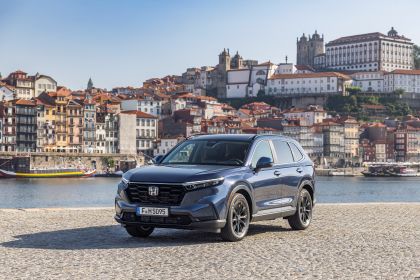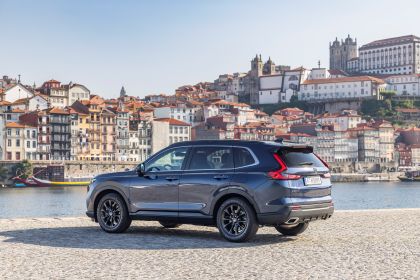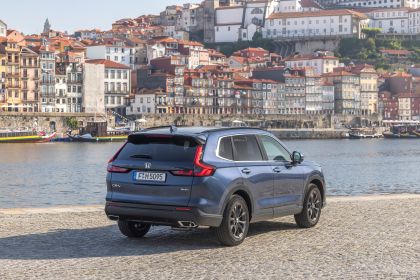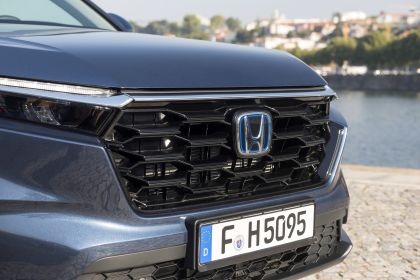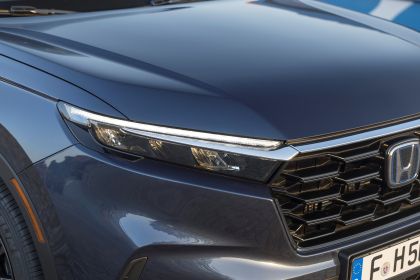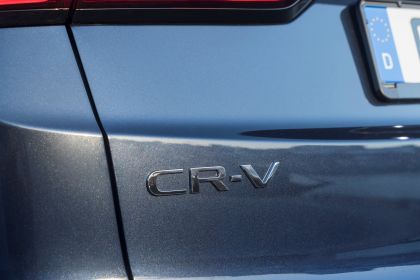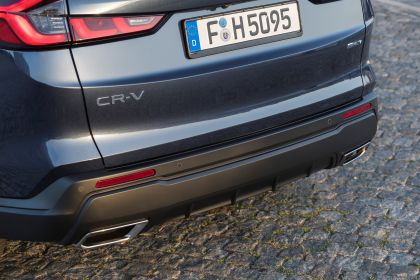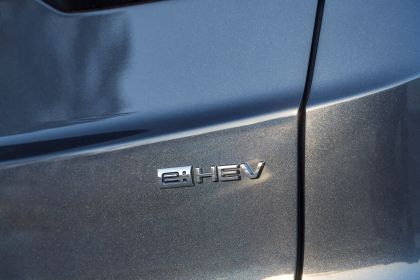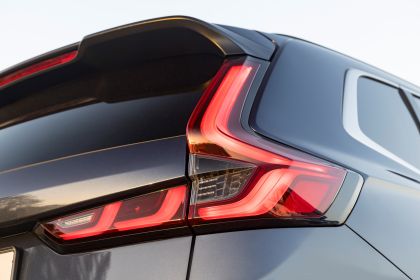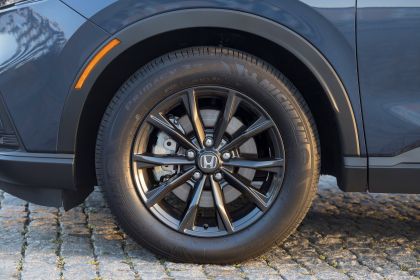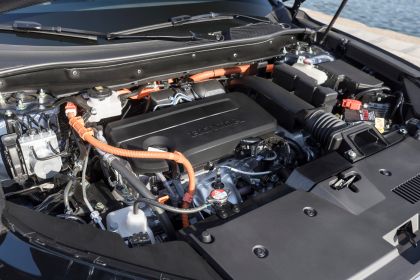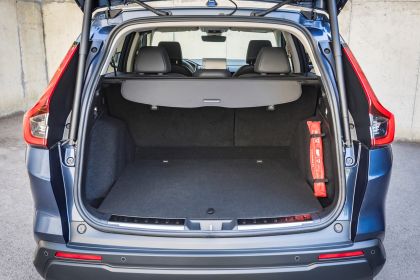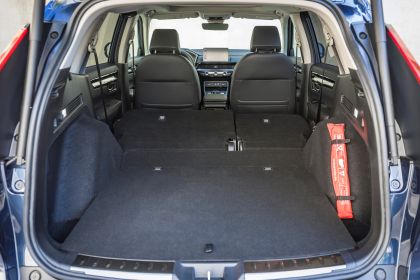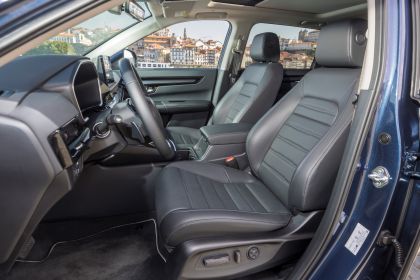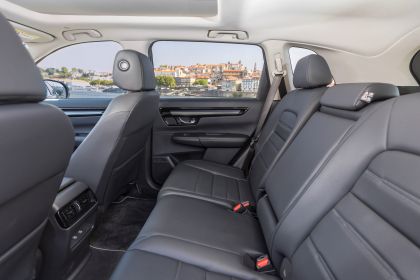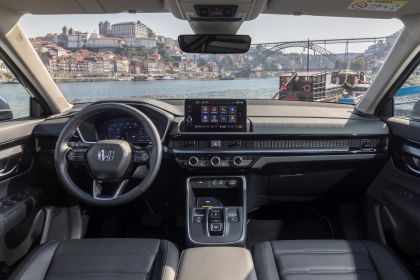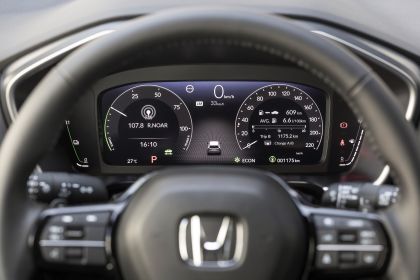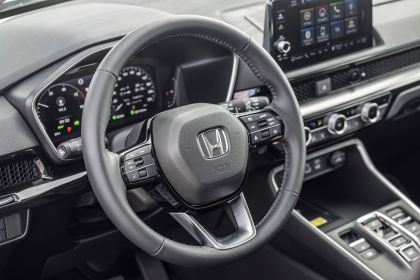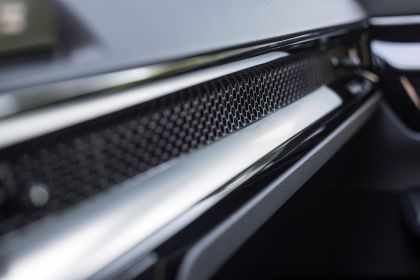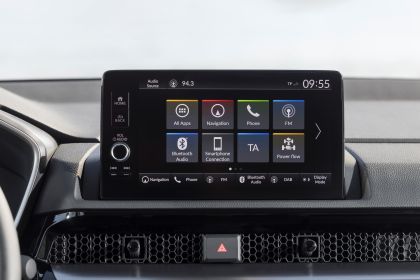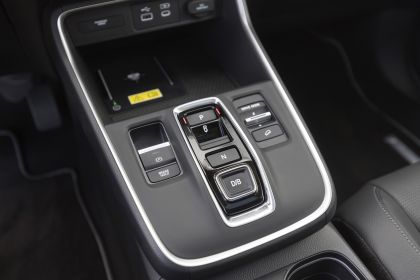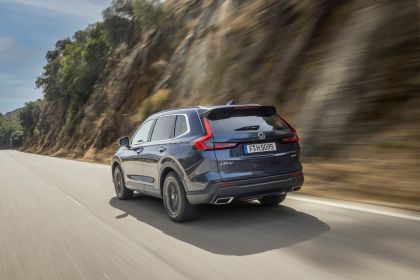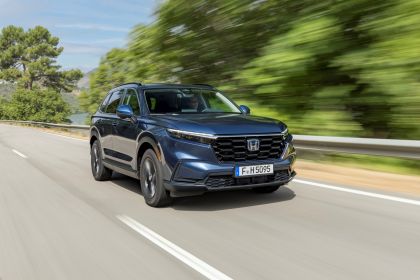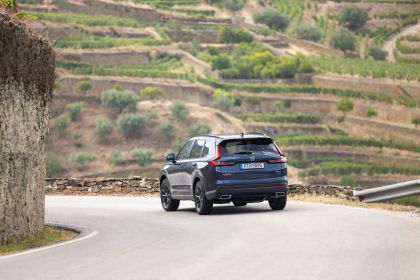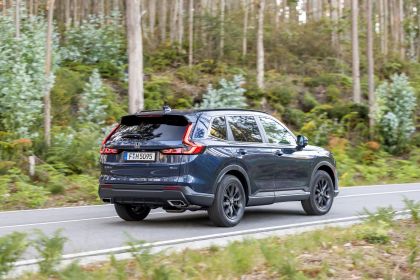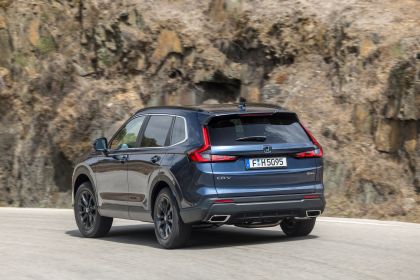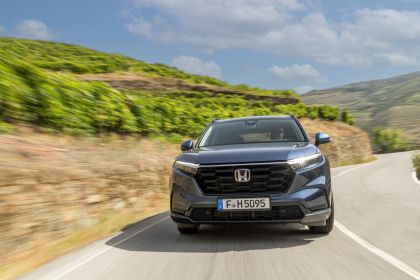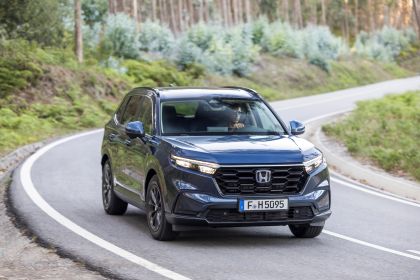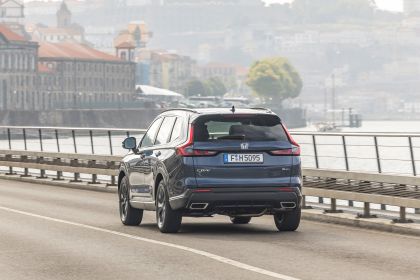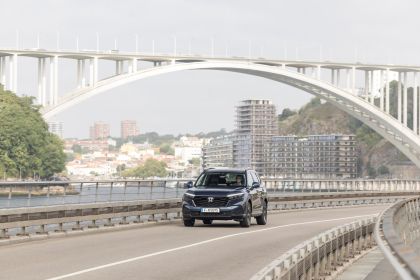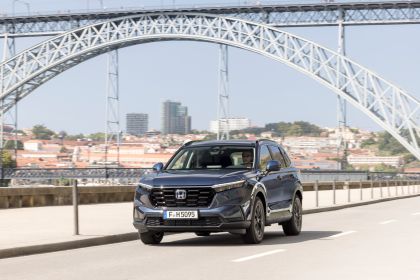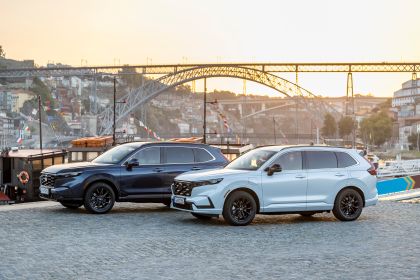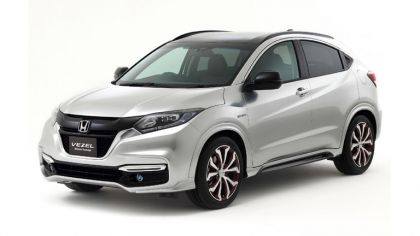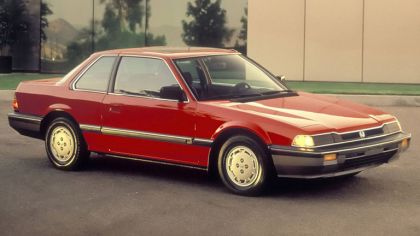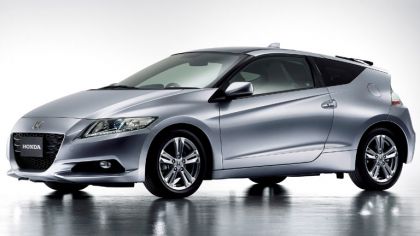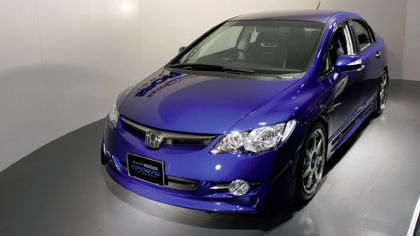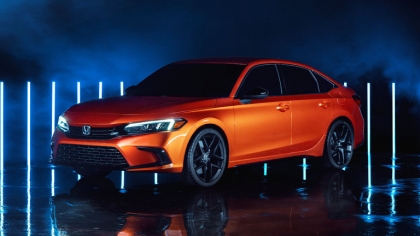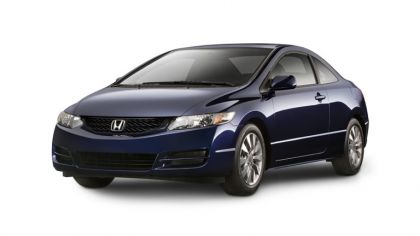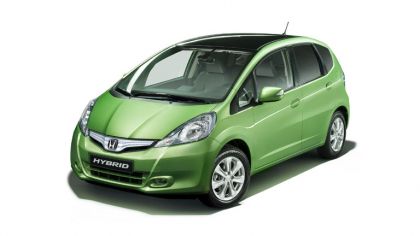The sixth generation of the Honda CR-V, the company's best-selling model globally, debuts with a bolder, more confident appearance and exceptional levels of practicality, safety, connectivity, and comfort.
The popular C-segment SUV will be offered with the choice of either a full hybrid (e:HEV) powertrain or, for the first-time on a European Honda, a plug-in hybrid (e:PHEV) option, delivering dynamic performance and efficiency across the range. This expanded powertrain line up represents Honda's multi-pathway approach to electrification and offers customers a broad range of products.
The familiar e:HEV powertrain has been revised and updated for the new CR-V, and now features a more energy-dense, downsized battery and more efficient motor, whilst the all-new e:PHEV, with its larger battery pack, offers up to 82km (51 miles) in all-electric range.
Engineers have refined every aspect of the latest model with a focus on the advanced and sporty values of the Honda brand, while aiming to make the ultimate all-round SUV. Greater sophistication of driver aids, active safety, and connected technologies, as well as the application of high-quality materials throughout the cabin, all serve to elevate the vehicle proposition.
Segment-leading levels of active safety have been achieved thanks to the first European application of Honda SENSING 360, the company's comprehensive omnidirectional safety and driver assist system, which removes blind spots around the vehicle and further contributes to collision avoidance.
The all-new Honda CR-V retains its familiar silhouette, but with a design evolution that increases its road presence. This starts with the more aggressive, defined styling at the front, with a large aperture and stylized grille opening, where e:HEV and e:PHEV variants are distinguished by their own designs.
At the rear, the vertical brake light and turn signal combination is a smart evolution of the model's instantly recognisable taillight design, with the purposeful LED lighting creating a new, evolved light signature at the rear of the vehicle.
Now with a longer wheelbase and wider stance, the Honda CR-V offers spaciousness comparable to that of a D-segment SUV. Not only providing rear seat passengers with best-in-class leg room, the model's larger proportions also create more boot space and increase stability at higher speeds.
"The all-new CR-V builds on everything this iconic model stands for - progressive design, a premium cabin, class-leading levels of practicality and comfort, and efficient and responsive performance," says Tom Gardner, Senior Vice President, Honda Motor Europe. "This latest iteration is the ultimate SUV, offering a unique and dynamic product that perfectly suits the current demands of the European market."
Hybrid and plug-in hybrid powertrains: The perfect blend of powerful driving performance and fuel efficiency
Honda introduces its first plug-in hybrid powertrain in the European region - the e:PHEV - on the all-new Honda CR-V, offering 82km (51 miles) of all-electric range. Alongside the upgraded hybrid e:HEV model, customers can expect an exhilarating driving experience with greatly improved environmental performance, responsive power delivery and reduced cabin noise.
Both options are built around the same 2.0-litre four-cylinder direct-injection Atkinson-cycle petrol engine, which has been revised for its application in the range topping SUV.
Improvements include a high-pressure, multistage direct-injection fuel system, while a low-temperature activating, high-performance catalyst improves environmental performance. The exhaust port surface area has also been expanded to further improve power output, while an all-urethane engine cover, noise and vibration insulation, and increased rigidity of the crankshaft, all help further improve interior refinement.
e:HEV
The e:HEV model will feature the most advanced iteration of Honda's award-winning full-hybrid powertrain, with the petrol engine pairing seamlessly with a newly developed version of the company's lightweight dual electric motor automatic transmission.
This latest iteration houses the propulsion motor and generator on a separate axis to allow for a 6.5% increase in torque to 335Nm without increasing design space. The former's maximum motor speed has also been increased by 1,500rpm to 14,500rpm, resulting in a 7% higher top speed.
Further revisions to the transmission include the addition of a second gear ratio when the engine is directly attached to the wheels. Joining the existing high ratio is a new low ratio - both of which have been optimised for the widest range of driving scenarios possible, ultimately increasing both the drive force at low speeds in engine drive mode and the frequency of driving in this efficient direct drive mode.
Rounding out the revisions to the hybrid powertrain is the inclusion of more compact Power Control Unit (PCU) and Intelligent Power Unit (IPU). Both have been downsized and revised to retain a similar energy density and efficiency, whilst reducing overall weight and physical dimensions.
The boost in power compared to the previous Honda CR-V means a more assured acceleration feel and improved responsiveness, with 0-100 km/h (62mph) acceleration taking from just nine seconds for 2WD models and 9.4 seconds for AWD variants, before heading on to a top speed of 194km/h (121 mph) for 2WD, and 187 km/h (116 mph) for AWD models.
Despite the gains in performance, the e:HEV system also offers increased levels of efficiency and a reduction in emissions with Combined CO2 as little as 134g/KM and just 5.9l/100km (40mpg) for 2WD models, and 151g/KM and 6.7l/100km (35 mpg) for the AWD.
e:PHEV
Building on the proven basis of Honda's e:HEV powertrain, the plug-in e:PHEV features a significantly larger 17.7kWh battery and a lightweight, high-output on-board electric charger. This increased electrical assistance means the engine speed can be kept much lower than before, further improving noise levels, refinement, and fuel efficiency at a variety of speeds. It also allows for an EV-only range of 82km (51 miles).
The increased electrical assistance offered by the plug-in hybrid system means that efficiency and consumption figures are just 18g/km and 0.8l/100km with a fully charged battery. When the battery is completely depleted, these figures will only increase marginally as the vehicle becomes a traditional hybrid, offering comparable performance to the 2WD e:HEV variant.
Clever packaging of the electrical components and having the battery mounted under the floor have allowed a boot capacity of 586 L. This has been made possible by optimizing the size of the unit's cooling components, allowing for its physical dimensions to be reduced, while extensive use of aluminium in its casing and construction have also seen the unit weight drop, despite the increase in energy density.
The charging port is located on the lefthand front fender and is opened by pressing the charge port lid. For the e:PHEV, the charging control in conjunction with the battery warmer allows to better deal with colder environments and also significantly improves recuperation capability at lower temperatures. When the battery temperature is 25 degrees, the latest CR-V achieves a 100% state of charge in just 2.5 hours, thanks to the 6.8 kW charger output.
As part of the connected services offered on the e:PHEV, users can select a range of preconditioning and climate functions when charging to further improve efficiencies, reduce costs and increase comfort in all weathers. These functions include a timer, as well as temperature and operation time settings, meaning CR-V owners can schedule charging for the cheapest and most convenient times, and have the car automatically adjusted to the desired temperature before they walk out of their house to the car.
New driver comfort aids and Honda SENSING functionality with class-leading collision safety performance
The all-new Honda CR-V has been engineered to achieve industry-leading safety performance and is the first European vehicle to feature Honda's most advanced suite of Advanced Driver Assistance Technologies (ADAS) - Honda SENSING 360.
Advanced driver assist and advanced accident-avoidance functions alleviate the burden of driving and, when coupled with a stronger body construction, offer industry leading active safety performance and outstanding protection in the event of an accident.
Strong foundations
The exceptionally strong, rigid, and stiff platform provides the foundation for exceptional safety performance, incorporating new structural components for improved front, rear and side collision protection. The e:PHEV features an additional floor cross member for increased protection of the IPU and passengers in the event of a side impact.
There are eleven airbags in this latest model, including a new front centre airbag to prevent a collision between the driver and front passenger, and a new knee airbag for both the driver and front passenger.
Honda SENSING 360
Honda SENSING 360 features a 100° forward facing camera, millimetre-wave radar, and four corner radars to offer a complete 360° view around the vehicle. Object recognition by image, via the CR-V's updated front camera, and object detection by radar, allows the vehicle to identify road lines, verges, motorcycles, cyclists and other vehicles.
Everyday useful assistance
The fitment of the Honda SENSING 360 enables a range of new and updated features that provide an extra level of safety and convenience for the driver.
Included for the first time in any Honda model is Front Cross Traffic Warning, which reduces head-on collisions at intersections with poor visibility. The system informs the driver of vehicles to the left or right when moving off after a stop and when at low speed.
An advanced Traffic Sign Recognition System detects and recognises road signs and displays them on the instrument binnacle behind the steering wheel, as well as on the Heads-Up Display, working in conjunction with the Adaptive Cruise Control (ACC) to offer one-touch speed adjustment to specific speed limits. For the first time in Europe, the system also provides a pre-notification of signs, such as an upcoming 'stop' sign, to inform the driver as soon as possible and help them prepare for junctions.
The ACC has been updated and now works with turn signals to initiate acceleration when overtaking, smoothing the process for drivers. The system also offers low-speed follow functionality, cornering speed adjustment by road curvature and incline, enabling the CR-V to maintain a constant speed on descents.
Lane Change Collision Mitigation assists steering operation during lane changing to avoid a collision with a vehicle approaching from behind and in the next lane, notifying the driver with a warning sound.
Collision Mitigation Braking System helps bring the car to a stop if it determines that a collision with a vehicle detected in front is unavoidable. In this instance, it will also offer a warning sound, and if necessary, the brake will be automatically applied.
Also debuting on the CR-V is Traffic Jam Assist. This reduces the driver's workload in low-speed congested traffic by helping to keep the vehicle in its lane, starting from 0 km/h. When traffic congestion clears, the car seamlessly switches to the Lane Keeping Assist System.
To further reduce driver burden, Active Lane Change Assist is included for the first-time on CR-V, which assists steering operation when changing lanes and is triggered by use of the turn signal. Once the driver holds the one-touch turn signal, the radar system ensures that the next lane is clear before the vehicle moves over.
Another new feature for Honda CR-V is Parking Pilot, which provides further driver support by monitoring for parking spaces and highlighting on the infotainment screens a suitable position to begin assisted parking. Drivers can simply select the location to be parked in, and the camera and sonar sensors detect the surrounding conditions to automatically control the accelerator, brake, steering and gearshift operations to park and exit the vehicle. It can be activated in three easy steps with a dedicated switch and a touch of the screen, and then the car can be parked by checking the safety of the surroundings, significantly reducing the worries of parking in a large SUV.
Premium quality interior and class-leading spaciousness
Higher-quality textured materials feature throughout the all-new Honda CR-V's cabin with tactile switches and controls that are easy to understand and operate, creating a luxurious in-car experience that aligns with premium segment SUVs.
At the front is a clean, uncluttered, and low-set dashboard with a full-width air-vent, centrally mounted 9.0" infotainment screen and large 10.2" digital dial set behind the steering wheel - all arranged to further aid outward visibility.
Colours, materials, and fabric
Both e:PHEV and e:HEV models are set apart by individual styling cues, with the former receiving an exclusive metal honeycomb pattern across the centre dash including air vent outlet for a more premium and sporty finish.
Honda has taken a unified approach to interior colourways, which sees black-hued colours used across the dashboard and throughout the entire interior for a premium finish. The seats are also finished in a black fine genuine leather as standard, with bold quilted accents for a unified, premium feel.
Front heated seats are offered as standard, and are ventilated on the Advance grade, improving comfort on long journeys.
This is the first CR-V to adopt Honda's Body Stabilising Seat for front occupants, incorporating a planar resin mat structure to support the occupant's entire lower body, from the pelvis through lumbar spine, for greater stabilisation and support. This also improves the hip point position, making it easier to get in and out of the car.
In the rear, the Honda CR-V achieves the spaciousness of a D-segment SUV with best-in-class rear leg room - up 16mm on the previous model - while rear seat recline has increased 10.5° over the previous CR-V, with 8 selectable options.
The intuitive interior layout prioritises versatility, including the cup holder, storage trays and large capacity cubby box between the front seats. A sleek and ergonomic electric gear selector, with mode switches that are optimally positioned for ease of operation, ensures that the driver can easily access all important functions while on the move, while a newly designed central armrest is also now semi-automated, opening to 60 degrees automatically and a further 30 degrees manually.
New levels of practicality to suit a range of active lifestyles
Raising the bar in terms of load space practicality and interior functionality, the latest CR-V supports active lifestyles. This is typified by one of the largest rear load spaces in the class, with e:HEV models offering 587-litres of cargo space, and e:PHEV variants providing an additional 72-litres thanks to its adjustable two-level cargo floor.
The rear seats slide forward by up to 190mm, which allows for easy loading of longer items without the need to fold the seats down, while a low boot floor height, and flat, wide one-piece floor panel makes loading cargo easier.
This is aided by the updated tailgate, which has been developed with a new, quieter power lift module that reduces operating time. Hands-free operation is also possible, with automated walk-away close and optional vehicle locking on closure.
Sporty and powerful design: an evolution of a familiar silhouette
The all-new Honda CR-V has received a design upgrade across the board to create a more premium and sporty appearance. Wider and longer than the previous version, its expanded exterior creates a more purposeful stance, with a new styling theme that further increases its road presence.
Sporting stance
Now 10mm wider and 80mm longer than its predecessor, the latest Honda CR-V's silhouette has matured into that of a well-resolved and sporty SUV. Thanks to this larger footprint, the design has allowed the A-pillars to be positioned further rearward and the bonnet elongated for a more dynamic appearance. Combined with its bold horizontal lines and 40mm longer wheelbase, this is still a CR-V but with a contemporary twist.
This model's bolder, more aggressive styling is typified by the front grille, which features a new larger piano black mesh pattern. As such, e:HEV and e:PHEV versions are distinguished by their own individual designs that match their respective characters, with the latter featuring wider, more open hexagonal shapes for a more aggressive and sporty appearance.
Evolutionary silhouette
The horizontal lower window and crease lines form part of a sleeker side profile, as does the clever door handle redesign that further elevates the noiseless exterior view, thanks to the keyhole and parting line having been deleted.
Defined lower character lines and the double arc wheel arches add volume and depth to the vehicle's flanks, while at the rear, a new vertical tail, brake and turn light combination presents a sophisticated evolution of this model's instantly recognisable rear light cluster.
Honda has worked to improve the vehicle's aerodynamic properties through bold body styling. Beneath the grille, the low, wide valance is sporty and functional in its design, with e:HEV variants incorporating a shutter grille that opens and closes automatically to reduce aerodynamic drag and improve fuel efficiency.
Either side of this slim grille in the front valance, side vents create an air curtain that channels airflow through the bumper, while strakes on the wheel arches further reduce turbulence around the wheels. These combine with the aerodynamically optimised A-pillars, flatter underfloor and rear roof spoiler to improve air flow velocity under and around the Honda CR-V, providing greater stability at higher speeds.
Expressive finishes
Customers can choose from six exterior colours, including new rich Diamond Dust Pearl, Canyon River Blue Metallic and Gold Titan Metallic colours, all featuring for the first time on CR-V. The popular Premium Crystal Red Metallic, Platinum White Pearl and Crystal Black finishes are all carried over from the previous model.
This increased colour palette is complimented by more unified, cohesive detailing - with e:HEV models using matte black on trim garnishes and lower bumper sections, and e:PHEV models using piano black to pick out and highlight design details such as the rear spoiler, side mirrors and grill bar.
Smart 18-inch alloy wheels will be standard across the CR-V range - in a gloss Berlina Black finish for the e:PHEV, and Shark Gray metallic for the e:HEV model.
Dynamic driving experience with enhanced comfort and refinement
When developing the chassis of the all-new CR-V e:HEV and e:PHEV, the goal was to instil an increased sense of security and comfort for all occupants. This more dynamic driving experience is the result of revised steering and suspension components, reducing understeer and providing a greater sense of control behind the wheel.
Increased rigidity
The introduction of lighter, stronger materials within the Honda CR-V's new platform design have improved body rigidity, while greater stiffness comes from the application of reinforcement members on the B-pillar and at the base of the C-pillar to increase rigidity around body openings. Structural adhesives, as used in other recent Honda models such as the HR-V and Civic, make their debut on the CR-V, further optimising overall rigidity levels.
At the front, an all-new die-cast aluminium subframe has been deployed, which saves over five kilograms over the previous model. The switch to a die-cast material has not only saved weight but also helps maintain the rigidity of suspension geometry, ensuring a constant contact patch for the tyres.
This is complemented by an all-new high-rigidity rear subframe, with two new stiffeners added to the open box sections to supress any form of deformation and ensure an even, linear level of tyre contact at the rear. The rear support mounts have also been improved, with a 15% increase in their spring rate.
Honda paid great attention to improving driver comfort and creating a secure steering feel, particularly at high speeds. One example of which is a new steering control unit, which features an optimised steering assist control . This contributes to a sense of security at higher speeds and delivers a light and nimble feel at lower speeds for more instant reactions to driver input; making the CR-V feel more like a saloon behind the wheel.
Damper control
The Honda CR-V has been perfectly designed to deal with broken road surfaces and uneven terrain, thanks to a flatter ride that prevents unnecessary movement over large undulations. The e:HEV has been achieved via amplitude reactive dampers that make the damping force harder or softer based on the vibration frequencies from the road conditions.
The e:PHEV model receives a full adaptive damper system that reacts to a range of vehicle sensor data, including wheel speed, lateral and longitudinal g-force, and yaw rate. The system offers high levels of stability and ride comfort in Normal mode, whilst Sport mode increases the damping force, widens the operating range, and delivers a tighter, more controlled ride for dynamic driving.
All-wheel drive
To further increase the feeling of security, the e:HEV variant of the CR-V is also available with an evolved all-wheel-drive system, which features an all-new control system to actively distribute driving force. The previous CR-V's AWD system disengaged at higher motorway speeds to reduce drivetrain losses and improve overall efficiency, but the latest model actively retains control of the rear axle for increased grip on fast, undulating and sweeping roads - in all conditions.
Noise, vibration, and harshness (NVH) levels have also been significantly reduced with this latest generation AWD system. By reducing the diameter of the constant velocity (CV) joint, the prop shaft's rotational fluctuations have been lessened, improving quietness and overall cabin comfort levels.
Drive modes and electric assistance
The latest Honda CR-V offers Normal, Sport and Econ drive modes, while the e:PHEV also features EV and Advanced Eco-assist options. There is also a new Snow mode for this model, which reduces traditional throttle response to minimise wheel spin and maximise grip in slippery conditions.
In addition, towing performance has been greatly improved with the addition of a low ratio lock-up and new Tow driving mode. This allows the e:PHEV variant to pull up to 1,500kg (braked) and e:HEV up to 750kg, vastly increasing the flexibility and usability of the vehicle. Tow mode keeps the engine revslow with a low gear ratio lock-up clutch and battery assist when towing uphill, while Hill Descent Control enables secure deceleration using only the accelerator pedal.
The e:PHEV also features a click mechanism on the accelerator pedal to provide feedback to the driver when they reach the limit of electric-only acceleration. When the driver exceeds this range, and requires more speed, the engine will seamlessly start-up to generate maximum electric energy for powerful acceleration . Alternatively, drivers can use this click mechanism as a cue to ease off and remain on electric power.
Extensive technology package provides new levels of connectivity for customers
The all-new Honda CR-V seamlessly integrates itself with customer's busy lives, featuring an extensive package of technology, including a revamped infotainment system and connectivity options.
Central to this is the updated HMI, designed to minimise up and down eye movement and to enable a more natural use of the system. For the first time on CR-V, a head-up display is projected directly onto the windscreen, allowing drivers to see a broader range of speed, driver assist and navigation information in a clearer resolution.
The navigation system has been updated with Predictive Eco Assist, which assists eco-driving by monitoring for downhill sections that will enable energy recuperation and improve real world economy. The Honda CR-V e:PHEV also plans how the battery will be used over an entire route to ensure the most efficient use of the hybrid system.
For e:HEV Elegance grades, a powerful eight speaker system is included as standard, whilst e:HEV Advance and e:PHEV Advance Tech grades gain a comprehensive high-performance BOSE Premium Audio system with 12 speakers across the cabin.
A 10.2-inch TFT digital instrument binnacle behind the steering wheel presents all necessary information in a timely manner through a sophisticated meter display, while automated functions promote reduced manual operation when driving.
At night, charging ports and key buttons are illuminated for ease of use, with four illuminated USB ports (1xType A and 1x Type C at the front and 2x Type C in the rear) that support a wider range of devices and increased charging speeds.
A dedicated wireless charging area at the front operates at 15W - three times more powerful than the outgoing CR-V. To ensure more stable charging, a cooling fan has also been integrated into this area to reduce heat generation.
Available on the e:PHEV model, Honda's Digital Key unlocks new connectivity options for users. Using Honda's smartphone application, customers can lock and unlock the vehicle, and turn on the engine in the same way as a regular key. However, unlike a regular key, the 'Digital Key' can be shared securely and digitally with selected invited drivers.
Finally, high-quality LED lighting has also been added throughout and is supplemented with soft ambient lighting in the centre console, doors, footwells and door handle recesses for a premium ambience throughout the cabin.

